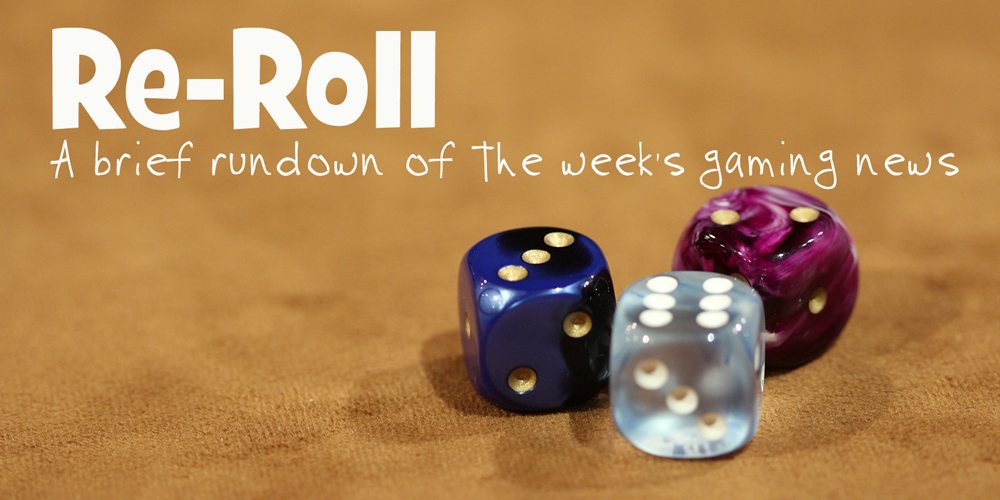Cheesonomics is a card game about—you guessed it—cheese. It’s a card game by Dale Tolley with elements of set collection and hand management (plus a bit of memory), and it’s currently on Kickstarter. I’ll warn you now: the game is pretty cheesy (it says so right on the box), so if you’re lactose-pun-intolerant then you might need to sit this one out.
At a glance: Cheesonomics is for 2 to 5 players, ages 8 and up, and takes about half an hour to play. The Kickstarter pledge amount is $29 for a copy of the game, which is expected to retail for $35. The age recommendation seems about right for me: the game is kid-friendly, though the cutesy appearance may turn off some of your hardcore gamer friends.
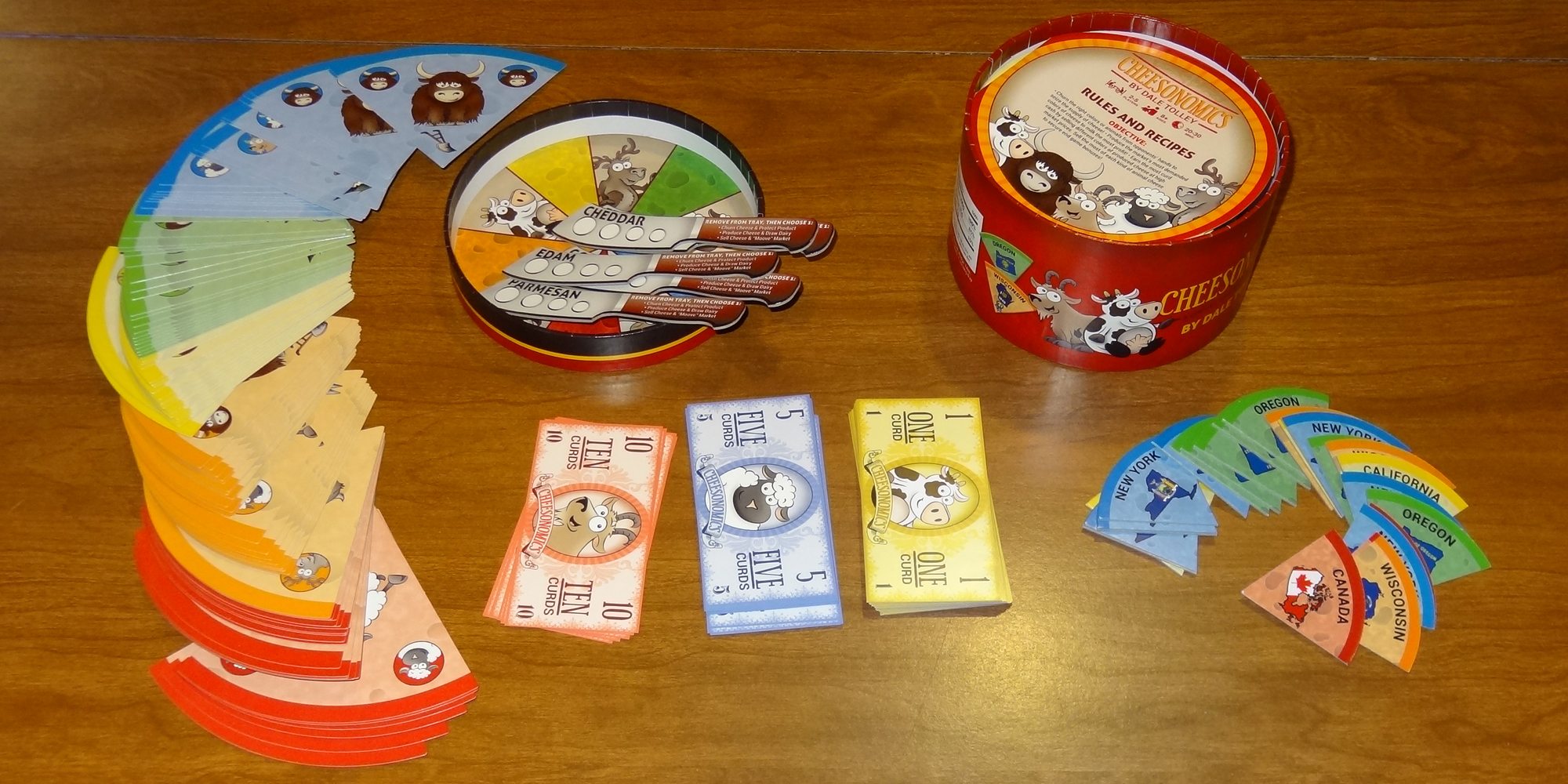
Components
Here’s what you get:
- 100 Cheese Wedge cards
- 25 Market Wedge tiles
- 120 Curd Cash bills
- 5 cheese knives
- 1 serving tray (lid)
The box is designed to look like a cheese round, and even has Nutrition Facts on the side. There are two versions, North America and Europe, although the main differences are the markets—Canada and some U.S. States vs. European countries. The game itself is played the same either way.
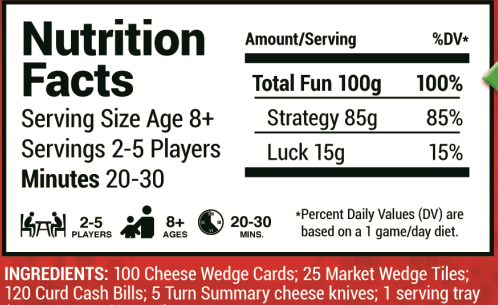
The cheese wedge cards are fairly large and I found that, while they’re pretty cute, they can be very hard to shuffle. Between the triangular shape and the curved edge, I really wasn’t sure how to mix them up other than by spreading them on the table in a messy pile and then gathering them up—and then it took some doing to get them all facing the same direction.
The cheese knives serve a couple purposes: each one is labeled with a different cheese name and they’re used for covering up wedges on the “serving tray” (the box lid) during gameplay. Each knife also has the three actions you can take printed on the handle. Again, they’re really cute, but not entirely practical. We found it difficult to place the knife in the serving tray without having it slide past the center, thus interfering with other wedges. And one player complained that it didn’t make sense to have the summary printed on the handle, because then you had to hold the blade to read it. Finally, the first few rounds people kept forgetting which knife was theirs because they’re all the same color—I guess if you have some real cheese-heads they wouldn’t have that problem.

The Curd Cash is paper money, and while it works okay, it reminds me why I prefer games that just use a track or wooden bits. Paper money can be kind of a pain to deal with. Fortunately, there’s not a whole lot of money exchanging in this game—you just gain money when you sell cheese, and you don’t pay any, so there’s not a lot of back-and-forth.
The components are all nice to look at and fit the theme, and I was pretty impressed when I first saw them. But they do feel a bit impractical when you’re actually playing the game—kids may get a kick out of oddly-shaped cards and little cheese knives, but my adult gamer friends ended up frustrated with the non-standard components.
How to play
The object of the game is to collect the most Curd Cash by selling cheese.
The game includes two variants: Mild and Sharp, depending on how tricky you want to make things. (There’s an Extra Sharp version, which is an expansion that will be included for Kickstarter backers if the project hits $16k.) I’ll explain Mild, and then mention the differences for Sharp.
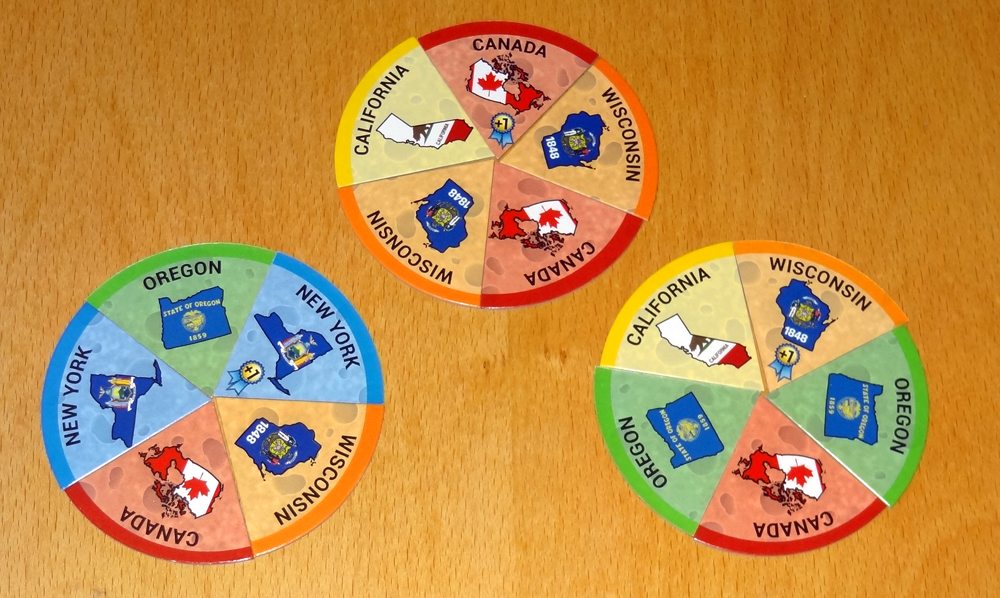
To set up, each player gets a cheese knife and five cheese wedge cards. The serving tray is placed in the center of the table. The market wedges are shuffled, and then 15 are drawn at random and formed into three circles in the center of the table. These represent the current market demand for cheeses. The rest of the market wedges are put back in the box. The player whose cheese knife comes first alphabetically goes first.
On your turn, you always take your cheese knife back if it’s in the tray, and then you get to take one of three actions: Churn Cheese, Produce Cheese, or Sell Cheese.
Churn Cheese: Pick either a color or an animal that isn’t currently covered by a cheese knife on the tray. Every player must give you a card of that type. If they don’t have one, they show you their hand and you get to pick one. Then, you return a card of your choice to each player. At the end of the churn, each player should be back to five cards. Finally, you put your cheese knife on the color or animal you called, which protects it until your next turn. (Note, however, that since the cheese cards come in various combinations of colors and animals, you may still wind up losing cards that you want when somebody else churns. Say you called “blue” and took a blue cow card—another player could call “cow” and take it from you.)
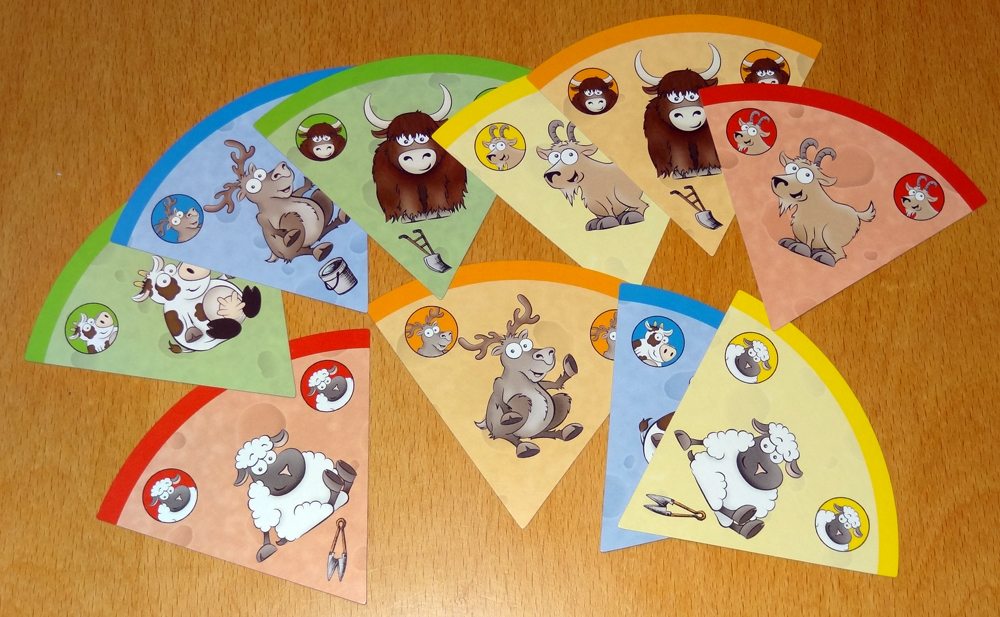
Produce Cheese: Pick a color or animal type, and play all of those cards from your hand face up in front of you. Wedges in front of you are now available to sell on future turns. Draw back up to 5 cards. If the deck runs out, then this will be the final round.
Sell Cheese: Pick a color or animal and sell up to 3 wedges of that type from the table in front of you. The market price for a wedge is equal to the number of market wedges of the matching color currently showing, plus any “blue ribbon” icons on those colors. (As an example, the market price based on the setup photo for red wedges would be 5—there are 4 red Canada wedges and one has a blue ribbon.) All of your sold wedges are kept in a face-down pile next to you. After you sell wedges, you get to “moove the market” by flipping over one market wedge matching a color you just sold, which changes market prices.
When the cheese wedge cards run out after somebody produces cheese, that triggers the end of the game. You’ll continue the round until each player (except the starting player) gets one more turn. At the end of the game, each unsold cheese wedge on the table is worth 1 Curd Cash, and these wedges and any left in your hand go to a common discard pile. Then there are end game bonuses for the cheese you sold during the game: for each animal type, if you have the most wedges of that type, you get 1 Curd Cash per card of that type. (E.g., if you had the most cows sold and you had 5 cows, you’ll get 5 Curd Cash.)
Whoever has the most Curd Cash wins!
Sharp variant: During set up, you’ll deal out some of the leftover market wedges. Each time you sell cheese, you’ll flip a market wedge and replace a wedge with one in your personal supply. Also, if you sell any cheese wedges that have the special icons on them, you get an extra action: discarding a market wedge to draw from the pile, or swap out a market wedge with an opponent.

Verdict
If you visit the Cheesonomics Kickstarter page and check out some of the updates, you can tell that designer Dale Tolley loves cheese. I mean, he really loves cheese. So he made a game that is all about cheese and is full of puns—because what goes better with cheese than puns, right?
The packaging is all really cute, from the cheese-wheel round box to the serving tray lid to the cheese knives. The rule book is pretty easy to digest (har, har) but my adult friends got a bit tired of the alliteration: Churn Cheese and Protect Your Product; Produce Cheese and Draw More Dairy; Sell Cheese and Moove the Market. And I’ve already mentioned that the cute wedge-shaped cards are pretty difficult to shuffle and handle, plus they take up a lot of space on the table when you’re setting out the cheese you’ve produced. There’s no really easy way to organize a whole bunch of large wedges so that everyone can see what you have.
That said, the game itself has some nice elements to it. Since you can only do one thing per turn, you often make decisions based on what’s currently showing. Somebody has a bunch of orange wedges produced and orange currently has a high market value? Better sell an orange wedge now, even though you don’t have as many, so you can reduce the price. If you remember that somebody collected a bunch of yellow cards, maybe you should churn cheese so you can try to snag one of them back—if you can remember what animals they had.
The churning is a bit strange, though. It’s basically a way to change up your hand of cards (and, to some extent, mess with your opponents) and try to get several of the same animal type or color so that when you produce cheese you can set down several cards at a time. However, if everyone churns on their turn, by the time it’s your turn to produce you may not have much of a combination left. It also slows the game down when players don’t have the color or animal that you call for—because then they have to show you their entire hand so you can pick a card to take. In our five-player game, that happened quite often, and when you’re presented with several hands of five cards each it can be overwhelming. Meanwhile, everyone else is waiting for you to choose cards to take, and then choose cards to return to everyone. I think if I were to play this more, I’d make a house rule that if you don’t have the right color or animal you just pick one and give it to the player—that would speed things up a bit.
The memory aspect comes in flipping over market wedges. Each wedge has two colors, one on each side, and so if you’re trying to influence the market it helps to remember what’s on the back. If you’ve got a good memory, you can shift the market in your favor while making small sales, and then sell off three same-color wedges at a really good price (assuming the other players don’t manage to stop you). I haven’t had time to try the Sharp variant, but letting each player have a supply of wedges adds in a little more choice, because now you’re changing two wedges per sale rather than one, and you can select one of the wedges that you’re adding in, which helps you stack the market even more.
Overall, I think Cheesonomics is a game that offers some good strategic depth despite its cutesy appearance, but the cheese jokes and cartoony animals aren’t for everyone. If you love cheese as much as Tolley, you may get a kick out of this game. For more information, visit the Cheesonomics Kickstarter page.
Disclosure: Gryphon Games loaned a prototype for this review.



